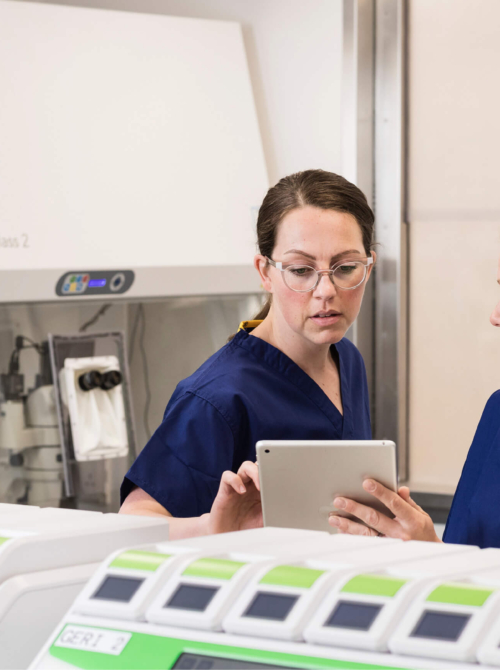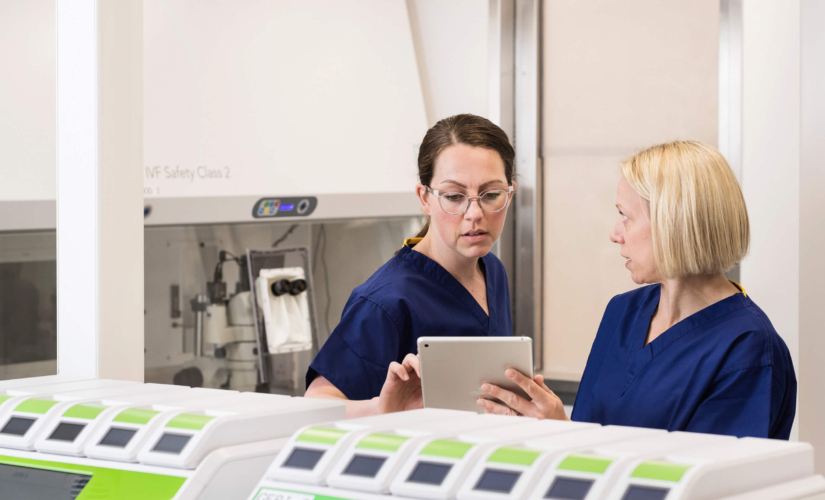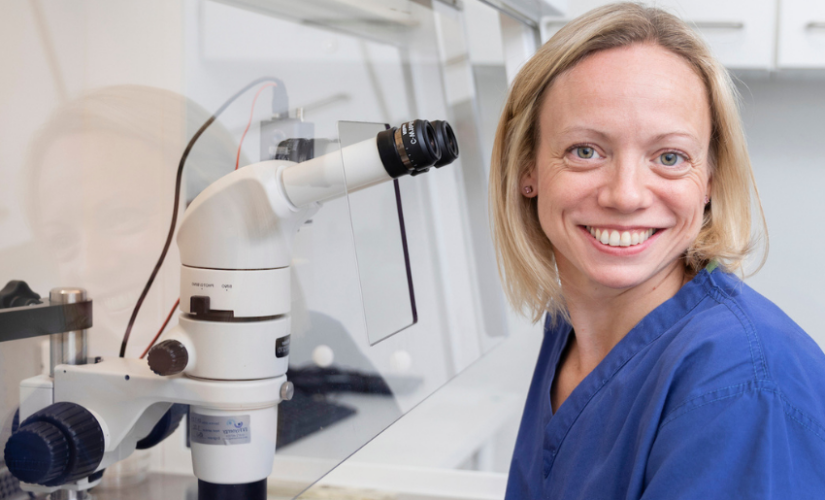Embryo Freezing and FET
Embryo freezing is a procedure that allows people to store embryos for later use. Emma Whitney, Lab Manager for The Evewell West London, looks into the facts around this stage of the IVF process.
The first successful pregnancy resulting from freezing a healthy embryo took place in the 1980s. Since then, many people have frozen embryos and used them later.
A person may decide to store an embryo if they hope to become pregnant in the future, to donate to others, for medical research, or for training purposes.
FET is undertaken using embryos created from a fresh IVF or ICSI cycle that have been cryopreserved (frozen) for later use.
Why freeze embryos?
Often within IVF treatment, there are good quality embryos which are not being used immediately. Instead of discarding them, there is the option to freeze them for use in the future (e.g. in case treatment doesn’t work, or to try for a sibling).
Embryo freezing may also be a good option for;
- people with genetic disorders that affect reproduction
- people who will soon undergo chemotherapy
- people who take medications that affect fertility
- same-sex couples and other LGBTQ+ people who wish to have children
And you may wish to consider freezing your embryos if:
- You want the option of using your embryos in future fertility treatment
- Your treatment needs to be cancelled after egg collection (for example, if you have a bad reaction to fertility drugs)
- You’re not yet ready to have children
What happens when embryos are frozen?
Sadly, not all embryos are suitable for freezing, so only good-quality embryos will be chosen to freeze. Embryos can be frozen at different stages of their development, when they’re just a single cell, at the two to the eight-cell stage, or later in their development from day 5 to 6 (a blastocyst).
The embryos will be put in a substance which replaces water in their cells. This protects the embryos from damage caused by ice crystals forming. They’ll then be frozen by fast freezing (vitrification) and stored in tanks of liquid nitrogen until you’re ready to use them (subject to certain time limits).
From here, the embryos remain in sealed containers at temperatures where almost no biological processes, such as ageing, can occur, until they are ready to be thawed and used in an embryo transfer procedure.
What’s a Freeze All cycle?
You may have heard of ‘freeze-all cycles’ before, this is when your eggs are fertilised after egg retrieval and all resulting embryos are frozen.
Some patients benefit from this process if they have a higher risk of OHSS (ovarian hyperstimulation syndrome); a rare and potentially dangerous condition that can arise when a patient is receiving stimulating hormones to increase egg production.
To reduce the risk of OHSS, we may recommend freezing the embryo and transferring it when the ovaries are no longer stimulated.
Another reason we may also recommend freezing all embryos is if there is any problem with the lining during the stimulation of the ovaries.
There is evidence that freezing all good-quality embryos from the fresh egg collection cycle and performing a frozen embryo transfer in a subsequent menstrual cycle (Freeze All Embryos) might help implantation and improve pregnancy rates.
Freezing embryos for PGT-A
We also use freeze-all cycles to test an embryo for a genetic disorder to ensure the baby has a lower chance of carrying or developing genetic diseases, or if the patient wishes to undergo PGT-A.
PGT-A (previously known as preimplantation genetic screening or PGS) involves checking embryos for abnormalities in the number of chromosomes. Embryos with an abnormal number of chromosomes (known as aneuploid embryos) have less chance of developing into a baby or may sadly result in a miscarriage.
To do PGT-A, embryologists remove a cell, or if at a later stage, several cells, from the embryo, which is then tested for any chromosomal abnormalities. The embryo can still develop with fewer cells, if the removal of cells is done carefully.
The embryos are then frozen whilst we await the results of the genetic testing, and any resulting euploid embryos – embryos containing a normal number of chromosomes – will be transferred as part of a usual frozen embryo procedure.
How successful is embryo freezing?
“Success rates for IVF using frozen embryos have been increasing year on year and are now much more comparable to, and often better than, rates using fresh embryos”, says Emma Whitney, Lab Manager at The Evewell West London.
The survival of embryos which have been frozen and thawed is >95%. For embryos which have undergone genetic testing, this is even higher, >98%.
And the chance of a successful pregnancy when transferring frozen-thawed embryos compared to fresh embryos is comparable across all ages.
A study published in the International Journal of Reproductive Biomedicine looked at the results of over 1,000 instances of embryo transfer involving either fresh or frozen embryos. The researchers found no statistical difference between the types of embryos, in terms of pregnancy rates or foetal health.
Does freezing damage the embryos?
The thawing of the embryos is a reversal of the freezing procedure. The embryo will be put into a special substance, which slowly encourages water to return into the cells, replacing the substance used to freeze the embryos. This will enable the embryos to return to their normal biological processes and continue developing.
It’s not uncommon for an embryo that does survive the freezing process, to lose a cell or two. However, in most cases, the embryo will recover and replace those cells – but if it doesn’t, then the embryo won’t be transferred.
What does a typical FET cycle look like?
The exact procedure for using frozen embryos varies, depending on individual personal circumstances.
If the patient is ovulating regularly, we may suggest having the embryo transferred with no fertility drugs. In this case, ultrasound scans may be used to check the lining of the uterus and blood tests will be used to check when the patient is ovulating, indicating the lining of the womb is ready to receive the embryo.
If periods aren’t regular, or the patient doesn’t have them at all, we may suggest using drugs to suppress the natural cycle and trigger a ‘false’ period. Medication can then be given to help prepare the uterus lining for receiving an embryo.
When the timing is right and your uterus is ready to receive the embryo, your embryo transfer procedure takes place.
What happens during a frozen embryo transfer?
Embryos are frozen as individuals, therefore, the embryologist will select the best embryo for thawing based on its overall quality and grading before it was frozen. The embryo will be thawed on the morning of the transfer, so the embryologists can observe if they have survived the thaw and how they are expanding.
Thawing ahead of the transfer and observing gives us an opportunity to call the patients if we need to update if the embryo hasn’t thawed well and if we need to cancel the transfer.
During a frozen embryo transfer, an embryo is released into the cavity of the womb with the use of a very thin tube, called an embryo transfer catheter, that passes through the vagina and the cervix.
After cleansing the cervix with solution, your consultant will place an empty transfer catheter through the cervix into position inside your uterus.
Then the embryologist will bring the catheter containing the now thawed embryo from the lab and we then feed the catheter with the embryo through the empty catheter that is in place.
You’ll be able to watch the bubble of air and fluid the embryo is contained in getting placed inside your uterus, and once the catheter is removed, the embryologist will check it under the microscope to make sure the embryo is transferred properly.
How long can embryos be stored?
In theory, a correctly frozen embryo can remain viable for any length of time. The embryos remain in sealed containers at temperatures where almost no biological processes, such as ageing, can occur.
There are examples of successful pregnancies resulting from eggs that people have stored for up to 10 years. However, no long-term research into embryo freezing exists because doctors have only been carrying out the procedure since 1983.
The standard storage period for embryos was up to 10 years in the UK, although the UK government has recently reviewed this and now you can freeze eggs, sperm and embryos for up to 55 years, with some limited conditions, therefore allowing younger patients to store their eggs or embryos and enable them to use their gametes for the full term of their reproductive lives.
If FET is something you’re interested in exploring, please contact The Evewell to arrange an in-depth conversation with one of our highly experienced embryologists to explore this subject.





